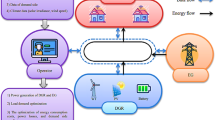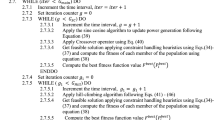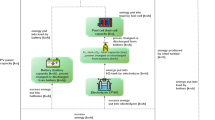Abstract
The economic emission dispatch problem is one of the most crucial problems for the future smart power network. The integration of renewable energy resources and the use of electric vehicles (EVs) are various techniques that have been suggested to deal with the increase in greenhouse gas emissions. However, to carefully examine various scenarios of integration of the above elements is important to reduce emission rates while considering economic constraints. In this research, the effectiveness of the use of photovoltaics (PVs) and EVs’ discharging/charging behavior is investigated from various perspectives in a hybrid economic emission dispatch. Here, a multi-objective model includes the optimization of two objectives: cost and pollution is suggested. Based on a penalty factor, we convert the multi-objective function into a single objective. For solving this non-convex, nonlinear and on-smooth problem, a modified whale optimization algorithm (WOA) is exerted to gain the optimum results. The idea of two sub-modifications is derived from Lévy flight algorithm and the mutation operator of the genetic algorithm. The verification of the suggested model is performed by the IEEE 30-bus system with 6-units. The simulated results illustrate that the incorporation of PV along with EVs in economic dispatch problem can improve the pollution emission, the economic costs, and convergence rate, effectively.














Similar content being viewed by others
Data availability
The data that support the findings of this study are available from the corresponding author upon reasonable request.
Abbreviations
- EV:
-
Electric vehicle
- \({\mathrm{F}}_{\mathrm{P}}\) :
-
Fuel cost function
- PV:
-
Photovoltaic
- \({F}_{\mathrm{PV}}\) :
-
PV cost function
- SOC:
-
State of charge
- \({F}_{\mathrm{EV}}\) :
-
EV cost function
- V2G:
-
Vehicle-to-grid
- \({E}_{\mathrm{T}}\) :
-
Emission function
- WOA:
-
Whale optimization algorithm
- \({Z}_{i}\) :
-
Number of POZs of unit i
- MOP:
-
Multi-objective problem
- \({\mathrm{UR}}_{\mathrm{i}}\),\( {\mathrm{DR}}_{\mathrm{i}}\) :
-
Up and down ramp rates of unit i
- \({\lambda }_{\mathrm{C}}\),\({\lambda }_{\mathrm{D}}\) :
-
Coefficients of the charging and discharging efficiencies
- \({P}_{\mathrm{PV},\mathrm{Rated}}\) :
-
Rated power of PV unit
- \({P}_{\mathrm{charge}/\mathrm{discharge},\mathrm{t}}^{\mathrm{EV}}\) :
-
Charge/discharge power of EV
- \({\mathrm{N}}_{\mathrm{EV}}\) :
-
Number of EVs connected to the network at hour t
- \({P}_{i,t,j}^{L}\) , \({P}_{i,t,j}^{U}\) :
-
Lower and upper limits of the jth POZ of unit I at hour t
- \({P}_{i,t}\) :
-
Generating power of ith unit at hour t
- \({\uppsi }_{\mathrm{pre}}\)/\({\uppsi }_{\mathrm{dep}}\) :
-
Present/departure state of PEVs’ battery charge
- \({B}_{ij}\), \({B}_{0i}\),\({B}_{00}\) :
-
Power loss coefficients of the power system
- \({\mathrm{N}}_{\mathrm{EV}}^{\mathrm{max}}\) :
-
Maximum number of EVs at a certain period of time
- \({P}_{i}^{\mathrm{min}}\),\({P}_{i}^{\mathrm{max}}\) :
-
Min and max power values of unit i
- \({\alpha }_{i}\), \({\beta }_{i}\), \({\gamma }_{i}\), \({\epsilon }_{i}\),\({\delta }_{i}\) :
-
Positive fuel cost and valve point coefficients of ith unit
- \({S}_{\mathrm{trip}}\) :
-
EVs consumption in the process of driving power
- \({a}_{i}\), \({b}_{i}\), \({c}_{i}\), \({e}_{i}\),\({f}_{i}\) :
-
Emission coefficients of ith unit
- \({\mathrm{P}}_{\mathrm{l}}^{\mathrm{max}}\) :
-
Max transmitted power through branch l
- \(\upeta \) :
-
System efficiency
- \({SOC}_{j,t}^{\mathrm{min}}\),\({SOC}_{j,t}^{\mathrm{max}}\) :
-
Min and max value of SOC
- \({\mathrm{P}}_{\mathrm{i},\mathrm{t}}^{\mathrm{EV}}\) :
-
Power of jth vehicle
- \(\Delta t\) :
-
Dispatch interval
- \({\mathrm{P}}_{\mathrm{PV}}\) :
-
Output power of PV
- \({S}_{t}\) :
-
Battery remaining power at time stage t
- \({\mathrm{P}}_{\mathrm{STC}}\) :
-
Module maximum power
- \(\Delta S\) :
-
Average power consumption of unit distance
- \({\mathrm{I}}_{\mathrm{M}}\) :
-
Incident irradiance on the modules
- \(L\) :
-
Driving distance
- \({\mathrm{I}}_{\mathrm{STC}}\) :
-
Irradiance under standard test conditions
- \({S}_{\mathrm{min}}\), \({S}_{\mathrm{max}}\) :
-
Min and max power of battery
- \({\mathrm{T}}_{\mathrm{M}}\) :
-
Temperature of the module
- \({\varepsilon }_{PV}\) :
-
Module-dependent proportionality constant
- \(\mathrm{k}\) :
-
Temperature coefficient of the power
- \({C}_{\mathrm{PV}}\) :
-
Cost coefficient for PV
- \({\mathrm{T}}_{\mathrm{STC}}\) :
-
Reference temperature
- \({C}_{\mathrm{EV}}\) :
-
Cost coefficient for EV
- \({\mathrm{T}}_{\mathrm{amb}}\) :
-
Ambient temperature
- \({P}_{\mathrm{D},t}\) :
-
Demand of network at hour t
- \({\mathrm{F}}_{\mathrm{T}}\) :
-
Total cost function
- \({P}_{\mathrm{L},t}\) :
-
Active power losses at hour t
- \(D\) :
-
The whale and its prey distance
- \(iter\) :
-
Current iteration
- \(A, C\) :
-
Coefficient vectors
- \({\varphi }_{1}\) to\({\varphi }_{3}\) :
-
Random number in [0, 1]
- \(r\) :
-
Random vector
- \({K}_{1}\) and \({K}_{2}\) :
-
Constant values
- b:
-
The logarithmic spiral shape constant
- \({h}_{j}(X)\) :
-
Inequality constraints
- \(l\) :
-
Random number in [−1, 1]
- \({g}_{j}(X)\) :
-
Equality constraints
References
Faraji E et al (2021) Probabilistic planning of the active and reactive power sources constrained to securable-reliable operation in reconfigurable smart distribution networks. Elect Power Syst Res 199:107457
Rahmani E et al (2023) Probabilistic reliability management of energy storage systems in connected/islanding microgrids with renewable energy. Elect Power Syst Res 214:108891
Davoodi A et al (2021) Multi-objective techno-economic generation expansion planning to increase the penetration of distributed generation resources based on demand response algorithms. Int J Electr Power Energy Syst 138:107923
Goodarzi S et al (2020) Efficient linear network model for TEP based on piecewise McCormick relaxation. IET Gener Transm Distrib 13(23):5404–5412
Seifi A et al (2008) A novel method mixed power flow in transmission and distribution systems by using master-slave splitting method. Elect Power Comp Syst 36(11):1141–1149
Baziar A et al (2014) A novel adaptive modified harmony search algorithm to solve multi-objective environmental/economic dispatch. J Intell Fuzzy Syst 26(6):2817–2823
Yang W et al (2021) An enhanced exploratory whale optimization algorithm for dynamic economic dispatch. Energy Rep 7:7015–7029
Ahmed I, Rehan M, Basit A et al (2022) Greenhouse gases emission reduction for electric power generation sector by efficient dispatching of thermal plants integrated with renewable systems. Sci Rep 12:12380
Kavousi-Fard A et al (2015) An smart stochastic approach to model plug-in hybrid electric vehicles charging effect in the optimal operation of micro-grids. J Intell Fuzzy Syst 28(2):835–842
Tabatabaie S et al (2015) Optimal probabilistic reconfiguration of smart distribution grids considering penetration of plug-in hybrid electric vehicles. J Intell Fuzzy Syst 29(5):1847–1855
Huang Z, Fang B, Deng J (2020) Multi-objective optimization strategy for distribution network considering V2G-enabled electric vehicles in building integrated energy system. Prot Control Mod Power Syst 5(7):1–8
Gu W, Yu H, Liu W, Zhu J, Xu X (2013) Demand response and economic dispatch of power systems considering large-scale plug-in hybrid electric vehicles/electric vehicles (PHEVs/EVs): a review. Energies 6(9):4394–4417
Andervazh M, Javadi S (2017) Emission-economic dispatch of thermal power generation units in the presence of hybrid electric vehicles and correlated wind power plants. IET Generat Trans Distrib 11(9):2232–2243
Dey B, Roy S, Bhattacharyya B (2019) Solving multi-objective economic emission dispatch of a renewable integrated microgrid using latest bio-inspired algorithms. Eng Sci Technol Int J 22(1):55–66
Nazari-Heris F, Mohammadi-Ivatloo B, Nazarpour D (2020) Economic dispatch of renewable energy and CHP-based multi-zone microgrids under limitations of electrical network. Iran J Sci Technol Trans Electr Eng 44:155–168
Chen X, Tang G (2022) Solving static and dynamic multi-area economic dispatch problems using an improved competitive swarm optimization algorithm. Energy 238(3):122035
Chen X, Shen A (2022) Self-adaptive differential evolution with gaussian-cauchy mutation for large-scale CHP economic dispatch problem. Neural Comput Appl 34:11769–11787
Ahmed I et al (2022) Multi-area economic emission dispatch for large-scale multi-fueled power plants contemplating inter-connected grid tie-lines power flow limitations. Energy 261(B):125178
Ahmed I et al (2022) Multi-objective whale optimization approach for cost and emissions scheduling of thermal plants in energy hubs. Energy Rep 8:9158–9174
Gholami A et al (2014) Environmental/economic dispatch incorporating renewable energy sources and plug-in vehicles. IET Generation, Trans Distribut 8(12):2183–2198
Sreenivasulu G et al (2022) Dynamic economic dispatch of transactive energy market using dynamic programming with state-restructuring feature. Electric Power Syst Res 210:108045
Wu P et al (2022) An improved NSGA-III for the dynamic economic emission dispatch considering reliability. Energy Rep 8:14304–14317
Nie Q et al (2022) Cost compensation method for PEVs participating in dynamic economic dispatch based on carbon trading mechanism. Energy 239(A):121704
Garcia M, Baldick R, Siddiqi S (2019) A general economic dispatch problem with marginal losses. In: 2019 American Control Conference (ACC), Philadelphia, PA, USA, pp 2588–2595
Sheta A et al (2020) Nature-inspired metaheuristics search algorithms for solving the economic load dispatch problem of power system: a comparison study. In: applied nature-inspired computing: algorithms and case studies. Springer: London pp 199–230
Ansari J et al (2022) Decentralized LMI-based event-triggered integral sliding mode LFC of power systems with disturbance observer. Int J Electr Power Energy Syst 138:107971
Mirjalili S, Lewis A (2016) The whale optimization algorithm. Adv Eng Softw 95:51–67
Niknam T, Mohammad R, A-Abarghooee R, (2012) A new hybrid algorithm for optimal power flow considering prohibited zones and valve point effect. Energy Convers Manag 58:197–206
Kameswara K (2022) Day-ahead DSM integrated hybrid-power management incorporated CEED of solar thermal/wind/wave/BESS system using HFPSO. Sustainability 14:1169
Huijun L, Yungang L, Fengzhong L, Yanjun S (2018) A multiobjective hybrid bat algorithm for combined economic/emission dispatch. Int J Electr Power Energy Syst 101:103–115
Zhu J, James A (2001) Multi-area power systems economic dispatch using nonlinear convex network flow programming. Electr Power Syst Res 59:13–20
Ratan Bhowmik A, Kumar Cakraborty A (2015) Solution of optimal power flow using non dominated sorting multiobjective opposition based gravitational search algorithm. Int J Electr Power Energy Syst 64:1237–1250
Li L, Shen Q, Tseng M, Luo S (2021) Power system hybrid dynamic economic emission dispatch with wind energy based on improved sailfish algorithm. J Clean Product 316:128318
Gaing Z (2003) Particle swarm optimization to solving the economic dispatch considering the generator constraints. IEEE Trans Power Syst 18(3):1187–1195
Wulandhari L, Komsiyah S, Wcaksono W (2018) Bat algorithm implementation on economic dispatch optimization problem. Proced Comput Sci 135:275–282
Sutar M, Jadhav H (2022) An economic/emission dispatch based on a new multi-objective artificial bee colony optimization algorithm and NSGA-II. Evol Intel 26:1–13
Funding
The authors received no financial support for the research and/or authorship of this article.
Author information
Authors and Affiliations
Contributions
MZ took part in methodology, software, validation, formal analysis, investigation, resources, data curation, writing—original draft, Supervision, and project administration. AA involved in conceptualization, methodology, software, validation, formal analysis, investigation, resources, data curation, and writing—original draft.
Corresponding authors
Ethics declarations
Conflicts of interest
The authors declare that they have no known competing financial interests or personal relationships that could have appeared to influence the work reported in this paper.
Ethical approval
This paper does not contain any studies with human participants or animals performed by any of the authors.
Additional information
Publisher's Note
Springer Nature remains neutral with regard to jurisdictional claims in published maps and institutional affiliations.
Rights and permissions
Springer Nature or its licensor (e.g. a society or other partner) holds exclusive rights to this article under a publishing agreement with the author(s) or other rightsholder(s); author self-archiving of the accepted manuscript version of this article is solely governed by the terms of such publishing agreement and applicable law.
About this article
Cite this article
Zadehbagheri, M., Abbasi, A.R. Energy cost optimization in distribution network considering hybrid electric vehicle and photovoltaic using modified whale optimization algorithm. J Supercomput 79, 14427–14456 (2023). https://doi.org/10.1007/s11227-023-05214-2
Accepted:
Published:
Issue Date:
DOI: https://doi.org/10.1007/s11227-023-05214-2




